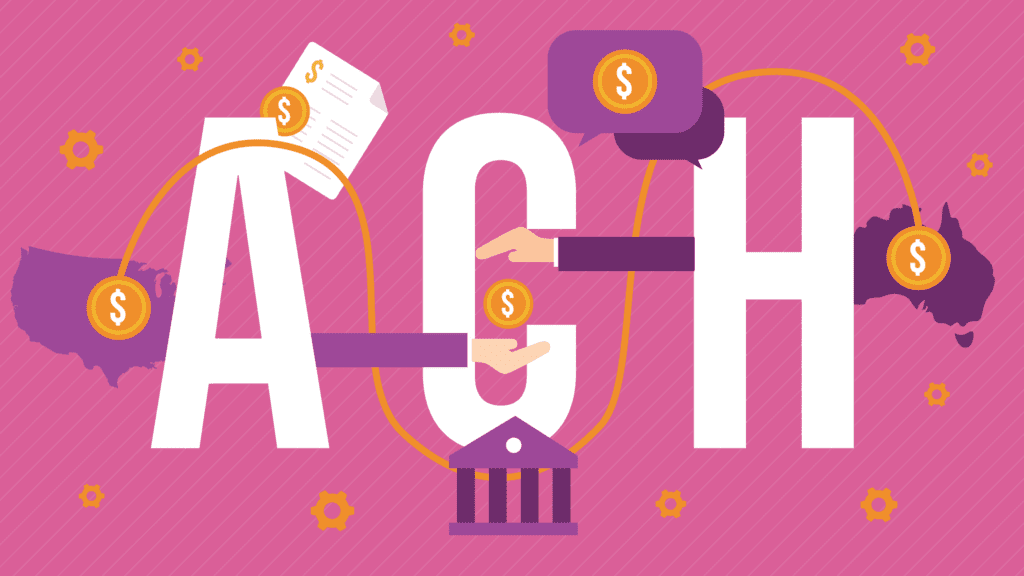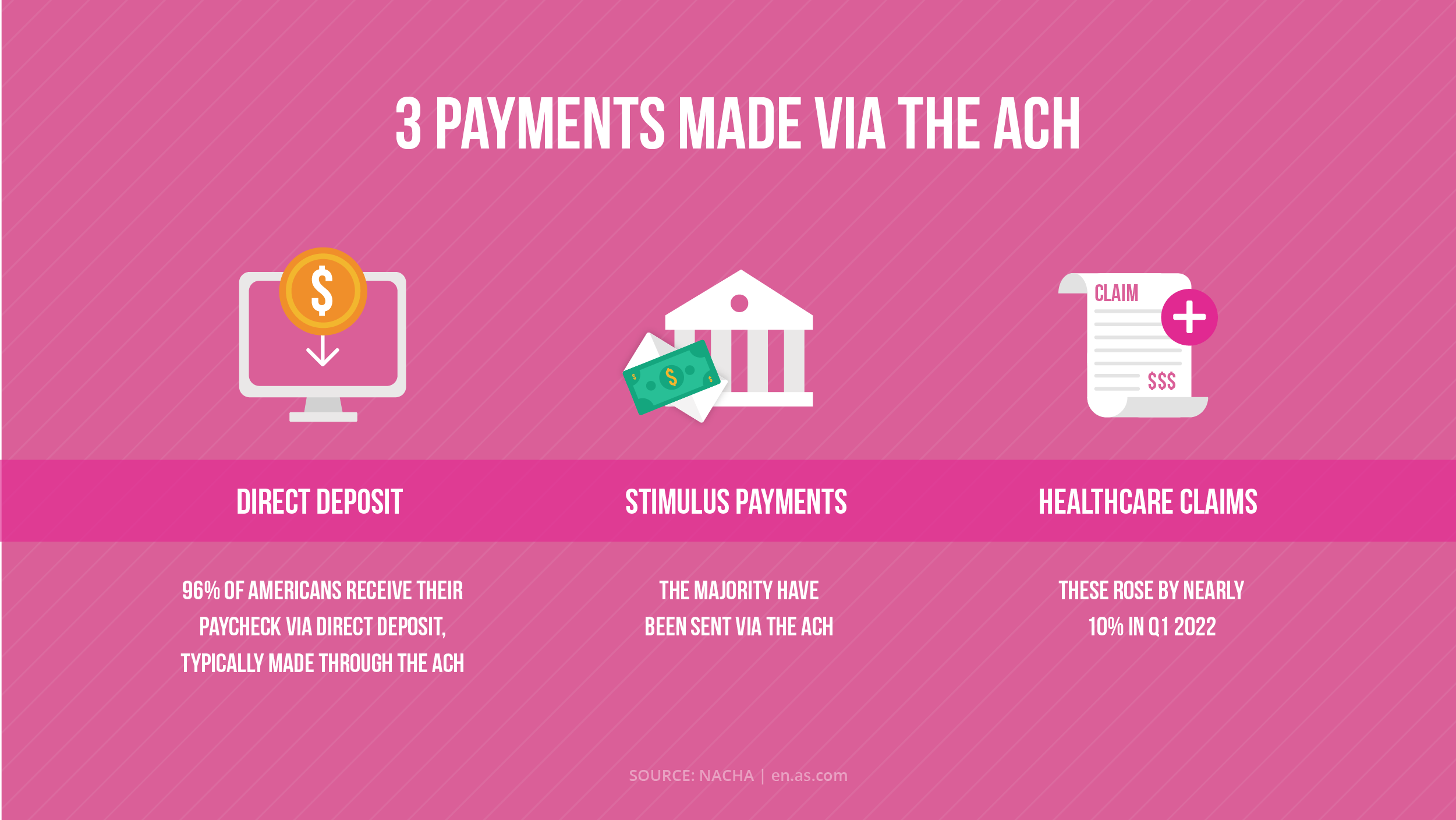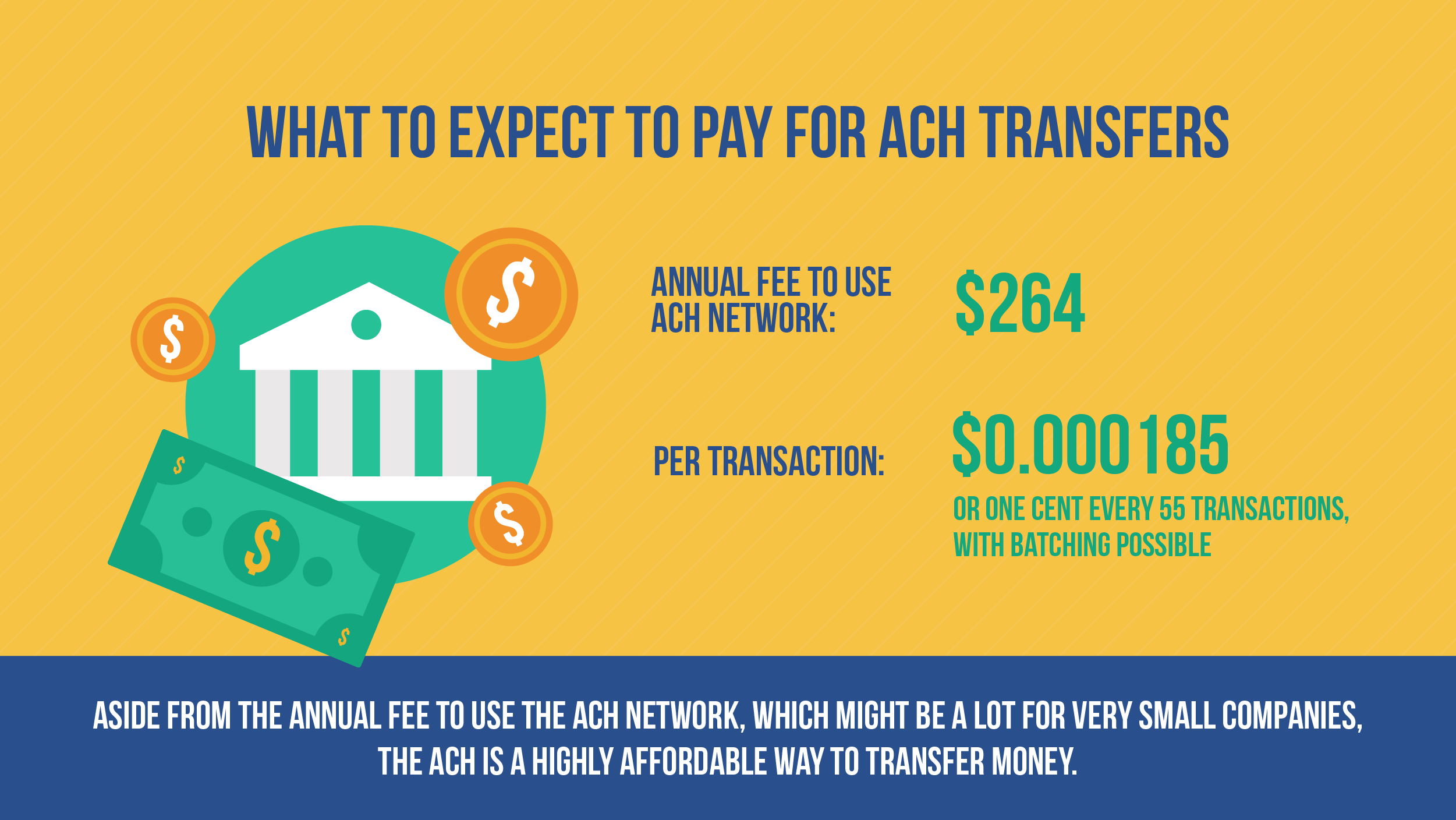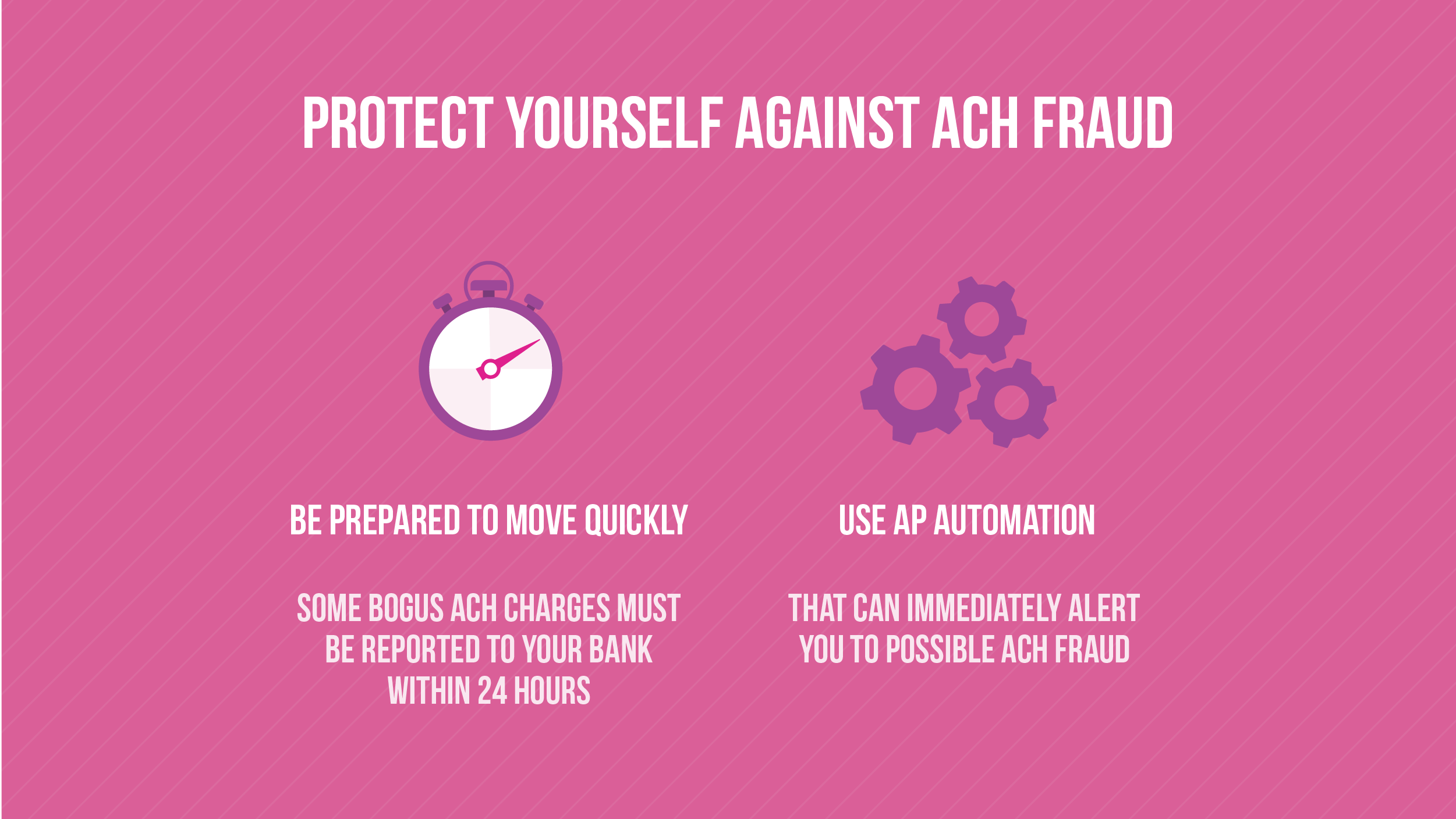How Stampli Makes it Easy to Set Up ACH Transfers

Businesses often turn to the automated clearing house, or ACH to make payments and the numbers only seem to be growing.
The National Automated Clearing House Association, or NACHA noted that B2B payments made through the ACH rose 15.5% from the first quarter of 2021 to the same quarter in 2022, reaching 1.4 billion payments. While other forms of payment, such as credit cards, debit cards, and checks remain popular in business, more and more companies seem to be catching on that the ACH is a reasonably fast, reliable, and low-cost way to make and receive payments.
Today, we’re going to look at what the ACH is, how to transfer funds through it, and how services like Stampli Direct Pay help businesses make easy use of the ACH.
ACH Transfers, Defined
When we say ACH transfer, what exactly are we referring to? Generally, when a business makes one of these transactions, it means they’re getting one of two types of ACH transfers: an ACH credit – a payment received – or executing an ACH debit – a payment made – through one of the most venerable forms of payment in the business world.
Let’s look at a few of the basics with ACH payments:
What the ACH is and How Often It’s Used
The ACH, which dates back roughly 50 years in the United States, with NACHA formed to administer the Automated Clearing House Network in 1974, is a virtual clearing house that businesses can use to route payments from one financial institution to another. “The real roots go back to 1968, when a group of California bankers became concerned about the growing volume of paper checks,” NACHA notes. “They feared it could outpace the technology and equipment used to clear those checks. So they formed the Special Committee on Paperless Entries, or SCOPE.”

Today, the ACH is used quite often for employee direct deposit, the method by which 96% of Americans receive their paychecks. But the ACH, which generally enables payments through the ACH Network or the U.S. Federal Reserve System, has other uses, too. One source noted in March 2021 that the ACH had been used to send out “the vast majority of (the latest round of) stimulus payments.” Healthcare claims paid through the ACH also rose 9% in the first quarter of 2022, according to NACHA. Utility bills can be paid through the ACH, too, with an assortment of other electronic payments possible to clear through there as well.
The ACH isn’t ubiquitous for business-to-business payments, with a 2021 survey report by Stampli and Treasury Webinars, “How & Why Companies Choose Payment Types” finding that just 24% of companies preferred to pay their suppliers via the ACH, with 30% opting for checks, 36% credit cards, and the remaining 10% other payment methods.
Still, it’s important for companies to have ways to easily use the ACH for the vendors and suppliers who’d like to be paid this way. Companies can also take full advantage of the benefits of the ACH when they’re easily equipped to use the network.
Why Businesses Use the ACH
In general, companies choose payment types for a variety of reasons, with the payment survey linked above finding that the top four reasons for choosing a particular payment form were: processing cost, at 46%; supplier preference, at 37%; it simply being the way they’d always done things, at 31%; and convenience for accounts payable staff, at 23%.
When it comes specifically to the ACH, Payments Journal notes two major benefits that could help to explain why $18.1 trillion was transferred via the ACH in a recent quarter, these benefits being:
- Availability, with most domestic U.S. banks able to accept payments through the ACH;
- Rock-bottom fees compared to wire, bank transfers or credit transactions, with Payments Journal writing that there’s “no cheaper way of moving funds between two accounts than via ACH – and it’s not even close.”
NerdWallet notes that there’s typically no fee to use the ACH for direct deposit or “most bill payments.”
What fees do exist with the ACH are fairly nominal, with NACHA setting 2022 Network Administration fees at an annual rate of $264 with $0.000185 per entry. This means that if a company has 1,000 employees getting paid twice a month via direct deposit, it would pay $268.44 annually to use this method of payment.

The $264 annual fee might seem prohibitive for small business, who might prefer fees-as-you-go payment options such as PayPal. But over time, ACH processing can save business owners a lot of hassles and money, with wire transfers can be as much as $40 for a single transaction, while fees for online payments can be 3-4%.
Info Needed for ACH Transfers
When a company decides to do an ACH transfer, while it’s not quite an instantaneous process, it shouldn’t be too much work to execute.
Here are a few things to do:
1. Determine if the ACH is Right For This Transaction
The first, and arguably most important step in setting up an ACH transfer, is to determine if it is indeed the right way to go.
The major determining factor for whether or not the ACH gets used in a B2B transaction might be how fast the money needs to arrive. Part of the reason the ACH is so cheap is that it’s not generally the fastest form of payment. While there’s been a rise in same-day ACH transactions in recent years, ACH payments generally need anywhere from 1-4 days for processing time.
There are some restrictions to be cognizant of as well, with transactions batched seven times a day, daily and monthly transfer limits, and cutoff times on business days for posting ACH payments, according to NerdWallet. It can also be tricky to make ACH payments from the U.S. to international destinations, with Stampli noting there is no global ACH system, though some countries have equivalent systems that can interface with their American counterparts.
The ACH tends to be used for smaller-dollar, high-volume transactions. For larger deals, or ones where money needs to move quickly or internationally, wire transfers can be the way to go. For anyone still curious, here’s a guide on when to opt for ACH payments or wire transfers.
2. Gather Banking Info
Once a business has determined that the ACH is the right payment type for a transaction, the next step is to gather all of the banking information that will be needed to complete the transaction.
The prospective payer can glean most of their account information from a physical check, or by visiting a company’s banking website. A company will need to know its bank routing and account numbers. It will need to specify the name of its financial institution and whether the bank account is for personal or business purposes.
A business will also need to be able to say how much the ACH payment will be for, determine if it’s an ACH debit or ACH credit, and make sure it doesn’t run the risk of having insufficient funds to move money.
ACH transfers often will get made from checking accounts, though it’s possible to schedule them from savings accounts as well. The only challenge for a payment processor to be aware of is that many financial institutions limit people to six or fewer withdrawals in a month from a savings account. Thus, businesses needing to arrange frequent money transfers via the ACH will probably want to look beyond savings accounts for their payments work.
One other thing: While this is more accounts receivable-related info, it’s also good to make sure that a business is set up to receive ACH payments from customers. In its ACH Quick Start Tool, NACHA encourages businesses to make sure their bank accounts are ACH-enabled.
3. Create Fraud Contingencies
ACH fraud isn’t common, but it happens and it’s been on the rise in recent years, as FICO notes. That site notes that the U.S. Federal Trade Commission received 2.2 million fraud reports in 2020, with one common scam being the Authorized Push Payment scheme that involves the ACH.
FICO notes that due to rising fraud, NACHA implemented a WEB Debit Account Validation Rule in March 2021, requiring “ACH Originators of WEB debit entries… to use a ‘commercially reasonable fraudulent transaction detection system’ to screen WEB debits for fraud.” This rule applies to banks, though it’s also wise for any business that makes or receives ACH payments to have some fraud contingencies in place.

One of these contingencies can be setting aside funds to cover a business’s liability for any wrongful charges via the ACH: $50 if the business catches the charge and notifies its bank within 48 hours and a maximum of $500 if the business does this inside of 60 days, as this guide notes.
That said, different banks might have different rules, with some fraudulent ACH transaction notifications needing to be made to banks within 24 hours, so it’s important to move as quickly as possible to catch them – and better, to use accounting and payment systems that can help do this.
Using to Stampli to Set Up ACH Transfers and Protect Your Business
For businesses looking for a pain-free way to schedule ACH transfers – and to receive a wide range of other payments and accounts payable benefits, here are a few things that Stampli can bring to the table.
Schedule ACH Transfers with Stampli Direct Pay
We started off by providing a best-in-class, SaaS-based AP automation platform that helps companies process invoices from the point a transaction is agreed upon to beyond the point of payment, when a business is reconciling the hundreds or thousands of invoices it might process each month.
One thing we realized in crafting our solution is that a lot of platforms allow a business to do everything when it comes to payment processing except make the actual payment. That’s why we debuted Stampli Direct Pay, which allows companies to make payments from within our platform.
With Stampli Direct Pay, companies can schedule ACH payments from directly within our platform (though it’s also possible to use our service to make payments outside of Stampli.) We’re payment-agnostic as well, meaning we won’t try to force the companies we work with to use a particular type of payment. For those companies that prefer it, it’s also possible to print paper checks inside of Stampli or even use Stampli Card, our innovative, virtual payment solution.
Easily Reconcile ACH Transactions with Stampli
One irksome thing about making ACH payments can be that, because they’re done in batches, it can be difficult to reconcile individual transactions. Being able to regularly reconcile transactions is an important part of accounting, helping ensure accurate balances between different sets of accounting books.
Stampli makes reconciliations easy by providing detailed information for every transaction. We can upload all supporting documents for a transaction, including invoices, receipt reports, and purchase orders.
Never worry again about if saving money on processing fees is enough of a benefit to justify inscrutable ACH information. With Stampli, companies will have a wealth of data about their ACH transactions right at their fingertips.
Catch Possible Fraud with Artificial Intelligence and Machine Learning
As we noted earlier, businesses have a limited reporting window with their bank accounts to minimize their losses to ACH fraud and obtain refunds.
Stampli helps companies move at lightning speed on their fraud reporting, with our system using AI and machine learning to immediately flag suspicious ACH transactions. Whether it’s a duplicate invoice, an Authorized Push Payment scheme, or any number of other attempts at malfeasance with the ACH, our platform can know immediately if something’s up.
It’s just one more way that Stampli helps the companies gain full advantage and benefit from the ACH.
We clean house at helping businesses use the clearing house. Try Stampli Direct Pay for ACH payments today.
